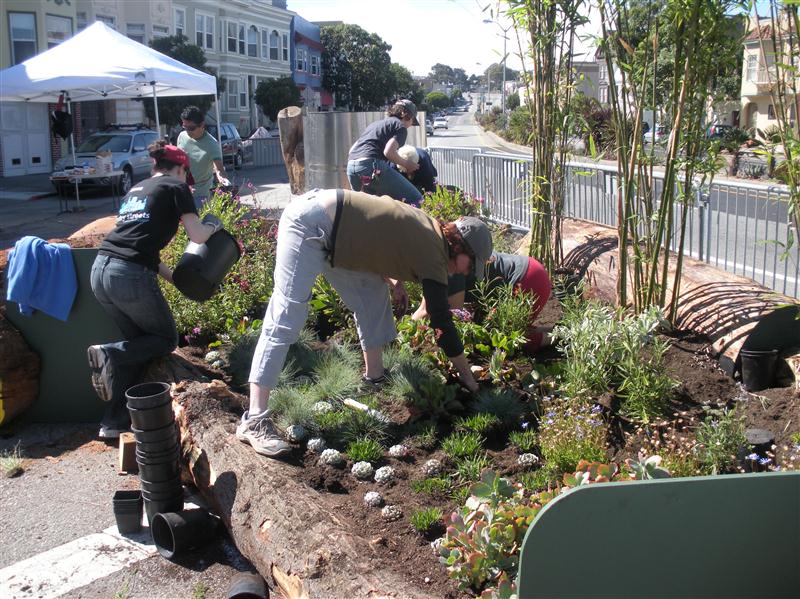
RETURN TO HOME PAGE
FEEDBACK

|
October
2009
RETURN TO HOME PAGE FEEDBACK |

Neighbors pitch in to plant greenery at a small plaza recently created
to replace the concrete triangle at Guerrero, San Jose Avenue, and
28th Street.
Photo courtesy Andres Power
By Heather World
Neighborhood moxie and city initiative have turned a confusing patch of roadway at the southeastern edge of Noe Valley into a plant-filled mini-park."Guerrero Park" opened last month for a two-month trial, and already parents with children, St. Luke's Hospital visitors, and coffee lovers are stopping by to sit and enjoy the flowers. Protected from the roadway by a barrier made of five-foot-tall steel tubes and tree stumps, the 9,000-square-foot plaza is surprisingly peaceful.
"People have been enjoying it in the evening with their kids and with dogs," says neighbor Will Reichmann, who lives on San Jose Avenue directly overlooking the new park.
According to neighborhood activist Gillian Gillett of the San Jose/Guerrero Coalition to Save Our Streets, a pedestrian-friendly public space has long been needed to replace the concrete triangle at the intersection of Guerrero, 28th Street, and San Jose Avenue. She says more than a few drivers traveling north on San Jose Avenue have smashed into cars and buildings at 28th Street while trying to decide whether to curve onto the beginning of Guerrero Street or head straight on the spur that ends San Jose Avenue.
The mini-park closes off that spur, which is now accessible only by turning right on the next block, Duncan Street.
"You rationalize the intersection by sending visual cues to the drivers," says Gillett. "You create a public space, and you calm the traffic."
The new mini-park is part of a city initiative called Pavement to Parks, modeled on a similar program in New York City. Initiated by the mayor's office, the program is run by the Planning Department. About 12 projects are scheduled to open this year.
Construction on Guerrero Park started in August and was completed the week after Labor Day weekend.
"We're calling them outdoor laboratories," says project manager Andres Power. The spaces will evolve over time, based on what elements work. Costs are low: The city uses pro bono landscape designers and architects to create designs using surplus materials from city construction projects.
For the Guerrero Park plaza, the $20,000 price tag was paid by a $15,000 donation from California-Pacific Medical Center/St. Luke's Hospital and a $5,000 grant from Safeway.
Power says the city looks for donations from corporate entities that have a geographic connection to the space.
"We're looking for people who want to be good stewards," he says.
The San Jose/Guerrero Coalition itself has a history of good stewardship in the neighborhood. Neighbors dug out the concrete medians and planted trees and shrubs to more attractively divide the four-lane road.
In 2005 the group used a neighborhood improvement grant from Oakland's Metropolitan Transportation Commission to hire urban designers from a New York non-profit dedicated to improving and expanding public spaces. The Project for Public Spaces designers suggested greening the roadway and drew up plans. The Coalition published the drawings on its website, and in the summer of 2006 the design shared a San Francisco Street Renaissance award with the Octavia Boulevard/Hayes Valley Neighborhood Association.
"This idea was wildly popular," Gillett says.
The city liked it, too. Pavement to Parks sites are partly chosen based on a history of community involvement, thereby building on existing planning efforts or neighborhood visions, Power says.
"That's what allows us to go quickly," he says.
The San Jose/Guerrero Plaza took about three months to build. Architect Jane Martin created a border with the stainless steel tubes (former air-duct tubing from the Joe DiMaggio clubhouse in North Beach), which were bolted to the ground and filled with plants. Logs from fallen trees in Golden Gate Park were joined together and planted with excess shrubbery from the park's nursery.
Cup o' Java, a cafe across Guerrero Street, now brings over bistro chairs at 6 a.m. and takes them back at 10 p.m., says Lorena Olivas, who works at the cafe. A half-dome climbing wall for children and WiFi for the adults are in the works. Gillett also hopes to get tai chi classes organized for Sunday mornings.
As for car noise, Gillett says she guesses most people won't choose to be in the plaza during morning and evening rush hours. The area is quiet by city standards the rest of the day, she says.
Meanwhile, she believes cars are already being calmed. "It's obvious when you're here that traffic is slowing down."
Like all Pavement to Parks projects, the site has an initial two-month permit with an option to extend four months, Power says.
"There's a series of checks in which we'll go back to neighbors and talk about what might need to change, what works well," he says. "The idea is for the space to evolve over time."